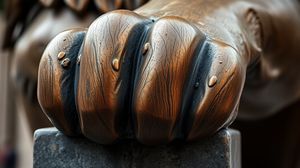
The Trafalgar Square Fourth Plinth is a unique and fascinating aspect of London's urban landscape. Originally designed for an equestrian statue of William IV, the plinth remained empty after funds ran out. It wasn't until 1999 that it was decided the plinth would serve as a showcase for contemporary art, resulting in a dynamic programme that has captivated both locals and tourists alike.
This plinth becomes home to a rotating series of art installations, each bringing a fresh perspective and often sparking debate. Artists from around the world compete to have their works displayed, turning this spot into a global platform for public art. The ever-changing artworks ensure that each visit to Trafalgar Square offers something new and unexpected.
One particularly intriguing installation was "Really Good" by David Shrigley. A sculpture of an outlandishly elongated thumbs-up sign, it was intended as an optimistic gesture, encouraging positivity and good deeds. Its quirky and humorous take on the traditional public monument brought smiles and conversation to passersby.
The history of the Fourth Plinth reflects a fascinating journey from unfinished architecture to a celebrated showcase for contemporary art. The Fourth Plinth Programme is now a prestigious commission in the art world, providing artists the opportunity to reach millions of people within this historic setting.
An unusual feature of the Fourth Plinth is its ability to be a mirror to society, with works often reflecting current social, political, and cultural themes. This has positioned it not just as an art installation but as a space for dialogue and reflection in the heart of London.
Standing proudly amidst the grandeur of Trafalgar Square, the Fourth Plinth serves as an invitation for all to engage with art outside the confines of traditional galleries. This blend of history, art, and community participation makes it an unmissable highlight within London's rich tapestry of experiences.

Making the Most of Your Visit:
You have to keep an eye on the Fourth Plinth Commission's announcements, as new installations are typically unveiled every one or two years. You don't want to miss the big reveal if you're in town during that time.
Sneak a peek behind the scenes by following the Fourth Plinth's official social media accounts or website. They often share fascinating insights into the making of the installations, giving you extra context when you see the artwork in person.
If you're curious about the current artwork on the Fourth Plinth, make sure to look up reviews or interviews with the artist. Knowing what inspired the piece can hugely enrich your experience, as these artworks are often loaded with meaning and cultural commentary.
Try and visit both in the day and at night. Some pieces have different qualities or elements that are highlighted by natural light versus artificial lighting, giving you a completely different view and understanding of the piece.
Don't forget to take the time just to sit and absorb the atmosphere around the plinth. Trafalgar Square is a vibrant hub of activity, and the art installations often encourage you to reflect not just on the piece itself, but the bustling life around it.

Visiting Times & Costs:
The Fourth Plinth in Trafalgar Square is open to the public at all times, as it is located in an open-air public square. There is no entrance fee, so you can visit and view the plinth and its current installation without any cost.
Regarding accessibility, Trafalgar Square is designed to be accessible for most visitors. There are wheelchair-accessible routes and ramps within the square, although some visitors might need assistance based on their individual mobility needs.
The Fourth Plinth artworks are outdoors and can be viewed at any time of the day or night, although some lighting conditions will vary, affecting the perception of the artwork.

Address & Map:

Nearby:























